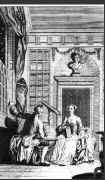


Prometheus's Fire: Sample Chapter(s)
1. Introduction
2. Background.......
3. The Society for the Employment
of Women and the Development of Technical Education
4. The Progress of Women's Employment
(1860)
5. The Establishment of the Queen's Institute
6. The Sequel
7. References
Introduction
Dublin was the first city anywhere in the British Isles, or indeed in Europe, to offer upper class women technical and vocational training with waged employment as the immediate goal. This educational pioneer was founded in 1861 and its programme of "industrial educational" for middle class women secured students and sponsorship for just over twenty years Loyally christened the Queen's Institute it enjoyed the gracious patronage, some limited financial support and the wholehearted approval of the great Victoria herself as well as other members of the Royal. Family.
Plate 19.1 : Two science students in
the mid eighteenth century.
Frontispiece of Benjamin Martin's "The Young Gentleman and Lady's
Philosophy." ( Courtesy of Bodlean Library, Oxford ).
It served as a model and a forerunner for other institutions with similar aims so that by the end of its two decades the expediency of vocational education for middle class women had become an integral part of their developing educational aims.
The Queen's Institute is a fascinating example of women trying to help themselves in a practical way. Unlike other institutions being mooted in England at the same time, it did not take as its model the privileged liberal education traditionally enjoyed solely by men. Its historical interest lies in the fact that in accepting that women had to be self sufficient it attempted to produce not merely decorative but useful and independent members of society. Its goal was to cater for women who had recognised that they had to fend for themselves and that to live in respectable decency they must acquire the skill of earning an adequate wage.
Victorian society may have paid lip service to the notion of the protection of the weaker sex, especially those of the higher castes, but other, more perceptive observers were fully aware of the appalling poverty in which many ladies lived. Deprived of their only financial support, the good will of a male relative - father, brother, husband - the plight of these women, whether single, widowed or deserted, was extreme.
It was a problem of enormous dimensions. Some contemporary estimates claimed that more than half of the female population of the British Isles had to fend for itself. According to the Census of 1861, the number of women aged fifteen or over in remunerative employment was 3,025,598, slightly less than half of the total number of women in that group (1). Paradoxically, it was more difficult for a middle class woman to find a job with a satisfactory wage than for a lower class woman. Too often prejudices of class and caste prevented her from taking the sort of work that provided the economic independence that some working class girls could enjoy. Ladies, almost always unskilled and ignorant of the demands of the job market, went on the streets or starved to death. It was a dilemma pinpointed by Mary Wollestonecraft and other women writers at the end of the nineteenth century - and it was this dilemma that prompted the innovation of the Queen's Institute.
Some navigational notes: In most browsers, if you click on the 'Back' button, it will bring to to the point of departure in the document from which you came. Additional navigation options of local relevance are given at the foot of each page, thus:
